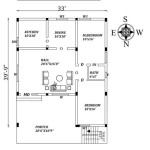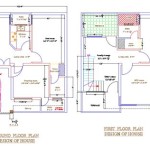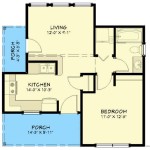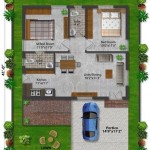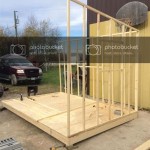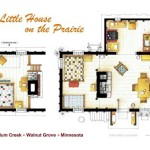Single-Story Modern House Floor Plans: A Comprehensive Guide
Single-story modern house floor plans, often referred to as ranch-style or rambler homes, have experienced a resurgence in popularity due to their accessibility, adaptability, and aesthetic appeal. These designs prioritize horizontal living, eliminating the need for stairs and fostering a sense of openness and connectivity throughout the home. Modern interpretations of single-story designs incorporate clean lines, expansive windows, and minimalist detailing, creating sophisticated and functional living spaces. This article provides a comprehensive overview of key considerations and design elements associated with single-story modern house floor plans.
The defining characteristic of a single-story home is, naturally, its lack of a second story. All living spaces, including bedrooms, bathrooms, living areas, and the kitchen, are located on the same level. This architectural feature offers numerous advantages, making these homes suitable for a wide range of homeowners, from families with young children to individuals seeking aging-in-place solutions. Single-story homes tend to require a larger footprint than multi-story houses with comparable square footage, as the space is spread horizontally rather than vertically. This necessitates considering lot size and orientation when selecting a single-story design.
Modern adaptations of single-story designs aim to maximize natural light and create a seamless connection between indoor and outdoor spaces. Large windows, sliding glass doors, and strategically placed skylights are commonly incorporated to flood the interior with sunlight. Open floor plans, where the kitchen, dining area, and living room flow together, are also prevalent in modern single-story homes, promoting social interaction and a sense of spaciousness. Material palettes typically include neutral tones, natural materials like wood and stone, and metallic accents to achieve a clean and contemporary aesthetic.
Accessibility and Universal Design Principles
One of the primary advantages of single-story homes is their inherent accessibility. The absence of stairs makes them ideal for individuals with mobility limitations, families with young children, and those planning to age in place. By incorporating universal design principles, single-story homes can be further optimized for accessibility and usability by people of all ages and abilities. Universal design focuses on creating spaces that are functional and comfortable for everyone, regardless of their physical capabilities.
Key elements of universal design in single-story homes include wider doorways and hallways to accommodate wheelchairs and walkers. Thresholds should be minimized or eliminated to create a smooth transition between rooms. Lever-style door handles are easier to operate than traditional knobs, and grab bars in bathrooms provide added support. Kitchens can be designed with adjustable-height countertops and appliances to accommodate users of different heights. Roll-under sinks and accessible storage solutions further enhance the functionality of the space.
Consideration should also be given to the placement of electrical outlets and light switches. Installing outlets at a higher level and light switches at a lower level can make them easier to reach for individuals with limited mobility. Smart home technology can also be integrated to control lighting, temperature, and security systems remotely, providing added convenience and accessibility.
In addition to interior modifications, the exterior of the home should also be accessible. A ramp or a gently sloping walkway leading to the front entrance can provide access for wheelchair users. Patios and decks should be designed with level surfaces and non-slip materials to prevent falls. Landscaping should be carefully planned to minimize obstacles and ensure clear pathways.
Open Floor Plans and Spatial Organization
Open floor plans are a defining feature of modern single-story homes, creating a sense of spaciousness and promoting social interaction. By removing walls between the kitchen, dining area, and living room, these designs foster a more connected and fluid living environment. However, careful consideration must be given to the spatial organization of these open spaces to ensure functionality and prevent the feeling of being overwhelmed.
Zoning is a crucial element in open floor plans. Defined zones for different activities, such as cooking, dining, and relaxing, can help to create a sense of order and purpose within the larger space. This can be achieved through the use of furniture placement, rugs, and changes in flooring materials. For example, a large area rug can help to define the living room zone, while a kitchen island can serve as a visual barrier between the cooking area and the dining area.
The arrangement of furniture is also critical in open floor plans. Furniture should be strategically placed to create clear pathways and encourage conversation. Avoid blocking walkways with furniture, and consider using furniture to delineate different zones within the space. For example, a sofa can be used to define the edge of the living room zone, while a bookshelf can create a separation between the living room and the dining area.
In addition to furniture placement, lighting plays a significant role in defining zones within an open floor plan. Different types of lighting can be used to create different moods and highlight specific areas. For example, recessed lighting can be used to provide general illumination, while pendant lights can be used to highlight the kitchen island or dining table. Task lighting can be used in the kitchen to provide focused illumination for food preparation.
Sound control is another important consideration in open floor plans. Without walls to absorb sound, noise can travel easily throughout the space. To mitigate this issue, consider using soft materials like rugs, curtains, and upholstered furniture to absorb sound. Acoustic panels can also be installed on walls and ceilings to reduce echo and reverberation.
Maximizing Natural Light and Outdoor Connections
Modern single-story homes prioritize natural light and a strong connection to the outdoors. Large windows, sliding glass doors, and skylights are strategically placed to flood the interior with sunlight and provide views of the surrounding landscape. Outdoor living spaces, such as patios, decks, and courtyards, extend the living area and create opportunities for relaxation and entertainment.
Window placement is crucial for maximizing natural light. South-facing windows receive the most sunlight throughout the day, while east-facing windows capture morning sun and west-facing windows capture afternoon sun. North-facing windows provide diffused light, which is ideal for studios and offices. Consider the orientation of the home and the surrounding landscape when determining the placement of windows to optimize natural light and minimize glare.
Skylights are an excellent way to bring natural light into interior spaces that may not have access to windows. They can be particularly effective in bathrooms, hallways, and kitchens. Operable skylights can also provide ventilation, helping to keep the home cool and comfortable. However, skylights should be carefully placed to avoid overheating and glare.
Sliding glass doors provide a seamless transition between indoor and outdoor spaces. They can be used to connect living rooms, dining areas, and bedrooms to patios, decks, and gardens. Consider using large sliding glass doors to create a dramatic visual connection and maximize natural light. Choose doors with energy-efficient glass to minimize heat loss and gain.
Outdoor living spaces should be designed as an extension of the interior living area. Patios and decks can be furnished with comfortable seating, dining tables, and outdoor kitchens to create inviting spaces for relaxation and entertainment. Consider adding a pergola or awning to provide shade and protection from the elements. Landscaping should be carefully planned to create a visually appealing and functional outdoor environment.
The integration of indoor and outdoor spaces can also be enhanced through the use of similar materials and finishes. For example, using the same flooring material on the interior and exterior can create a seamless transition and visually expand the living area. Similarly, using the same color palette on the interior and exterior can create a cohesive and harmonious design.
In summary, single-story modern house floor plans offer a multitude of benefits, including accessibility, open living spaces, and a strong connection to the outdoors. By carefully considering these design elements, homeowners can create functional, stylish, and comfortable living environments that meet their specific needs and preferences. The key lies in thoughtful planning and a focus on creating a space that is both aesthetically pleasing and highly practical for everyday life.

Modern One Story House Plot 20x17 Meter With 2 Beds Pro Home Decors

1 Story Modern Prairie House Plan Elk Park Plans South Porch Family

The Odyssey Single Y Display Home Ross North Homes Perth Beautiful House Plans Designs Exterior

Small One Story 2 Bedroom Retirement House Plans Houseplans Blog Com

The Odyssey Single Y Display Home Ross North Homes Perth House Layout Plans Modern Blueprints

Modern One Story House Plot 20x17 Meter With 2 Beds Pro Home Decorz

Unique And Modern Single Story 2 500 Sq Ft House Plans Blog Homeplans Com

Stylish One Story House Plans Blog Eplans Com

Minimalist Single Story House Plan With Four Bedrooms And Two Bathrooms Cool Concepts

One Story Modern Farmhouse Floor Plans

